Holy Roman Emperor
| Emperor of the Romans | |
|---|---|
| Former Monarchy | |
| Imperial | |
 |
|
| Imperial Coat of arms | |
| Francis II | |
| First monarch | Charles I |
| Last monarch | Francis II |
| Style | His Imperial Majesty |
| Appointer | Papal appointment |
| Monarchy started | 25 December 800 |
| Monarchy ended | 06 August 1806 |
| Current pretender | Position abolished |
The Holy Roman Emperor (German: Heiliger Römischer Kaiser, Latin: Imperator Romanum Sacrum) is a term used by historians to denote a medieval ruler, who as German King had in addition received the title of "Emperor of the Romans" from the Pope of the Holy Roman Catholic Church, and after the 16th century, the elected monarch governing the Holy Roman Empire, a Central European union of territories in existence during the Medieval and Early Modern period.
Charlemagne of the Carolingian Dynasty was the first to receive papal coronation as Emperor of the Romans. Charles V was the last Holy Roman Emperor to be crowned by the Pope. The final Holy Roman Emperor-elect, Francis II, abdicated in 1806 during the Napoleonic Wars that saw the Empire's final dissolution.
The standard designation of the Holy Roman Emperor was "Venerable Emperor of the Romans" (Imperator Romanorum Augustus). When Charlemagne was crowned in 800, his was styled as "most serene Augustus, crowned by God, great and pacific emperor, governing the Roman Empire," thus constituting the elements of "Holy" and "Roman" in the imperial title. The word Holy had never been used as part of that title in official documents.[1]
The word Roman was a reflection of the translatio imperii (transfer of rule) principle that regarded the (Germanic) Holy Roman Emperors as the inheritors of the title of Emperor of the Western Roman Empire, a title left unclaimed in the West after the death of Julius Nepos in 480.
Establishment of the Holy Roman Empire
After Charlemagne was crowned Roman Emperor by the Pope, his successors maintained the title until the death of Berengar I of Italy in 924. After that point the position was vacant until the time of Otto the Great (912–973). Otto is considered the first Holy Roman Emperor. Under Otto and his successors, much of the former Carolingian kingdom of Eastern Francia became the Holy Roman Empire. The various German princes elected one of their peers as King of the Germans, after which he would be crowned as emperor by the Pope. After Charles V's coronation, all succeeding emperors were legally emperors-elect due to the lack of papal coronation, but in all practical purposes they were simply called emperors.
Conflict with the Papacy
The title of Emperor (Imperator) carried with it an important role as protector of the Catholic Church. As the papacy's power grew during the Middle Ages, Popes and emperors came into conflict over church administration. The most well-known and bitter conflict was that known as the Investiture Controversy fought during the 11th century between Henry IV and Pope Gregory VII.
Succession
Successions to the kingship were controlled by a variety of complicated factors. Elections meant the kingship of Germany was only partially hereditary, unlike the kingship of France, although sovereignty frequently remained in a dynasty until there were no more male successors. Some scholars suggest that the task of the elections was really to solve conflicts only when the dynastic rule was unclear, yet, the process meant that the prime candidate had to make concessions, by which the voters were kept on side, which were known as Wahlkapitulationen (election capitulations).
The Electoral council was set at seven princes (three archbishops and four secular princes) by the Golden Bull of 1356. It remained so until 1648, when the settlement of the Thirty Years' War required the addition of a new elector to maintain the precarious balance between Protestant and Catholic factions in the Empire. Another elector was added in 1690, and the whole college was reshuffled in 1803, a mere three years before the dissolution of the Empire.
After 1438, the Kings remained in the house of Habsburg and Habsburg-Lorraine, with the brief exception of one Wittelsbach, Charles VII. Maximilian I (Emperor 1508-1519) and his successors no longer travelled to Rome to be crowned as Emperor by the Pope. Therefore, they could not technically claim the title Emperor of the Romans, but were mere "Emperors-elect of the Romans", as Maximilian named himself in 1508 with papal approval. This title was in fact used (Erwählter Römischer Kaiser), but it was somewhat forgotten that the word "erwählt" (elect) was a restriction. Of all his successors, only Charles V, the immediate one, received a papal coronation. Before that date in 1530, he was called Emperor-elect too.
Frankish Empire
Carolingian Dynasty (800–888)
| Portrait | Name | Coronation | Ceased to be Emperor | Relationship with Predecessor(s) | Coin |
|---|---|---|---|---|---|
| Charles I the Great |
25 December 800 | 28 January 814 | • N/A |
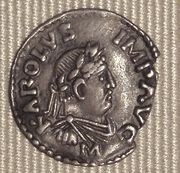 |
| Portrait | Name | Coronation | Ceased to be Emperor | Relationship with Predecessor(s) | Coin |
|---|---|---|---|---|---|
| Louis I the Pious |
1st 13 September 813 2nd 05 October 816 |
20 June 840 | • Son of Charles I |
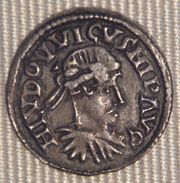 |
| Portrait | Name | Coronation | Ceased to be Emperor | Relationship with Predecessor(s) | Coin |
|---|---|---|---|---|---|
| Lothair I | 1st 817 2nd 05 April 823 |
29 September 855 | • Son of Louis I |
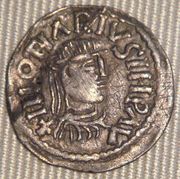 |
| Portrait | Name | Coronation | Ceased to be Emperor | Relationship with Predecessor(s) | Coin |
|---|---|---|---|---|---|
| Louis II | 850 | 12 August 875 | • Son of Lothair I |
 |
| Portrait | Name | Coronation | Ceased to be Emperor | Relationship with Predecessor(s) | Coin |
|---|---|---|---|---|---|
| Charles II the Bald |
29 December 875 | 06 October 877 | • Son of Louis I |
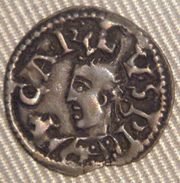 |
| Portrait | Name | Coronation | Ceased to be Emperor | Relationship with Predecessor(s) | Coin |
|---|---|---|---|---|---|
| Charles III the Fat |
12 February 881 | 13 January 888 | • Grandson of Louis I |
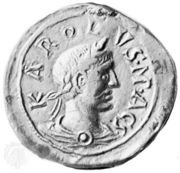 |
House of Guideschi (891–898)
| Portrait | Name | Coronation | Ceased to be Emperor | Relationship with Predecessor(s) | Coin |
|---|---|---|---|---|---|
 |
Guy III [2] |
891 | 12 December 894 | • Great-great grandson of Charles I |
 |
| Portrait | Name | Coronation | Ceased to be Emperor | Relationship with Predecessor(s) | Coin |
|---|---|---|---|---|---|
 |
Lambert II [3] |
30 April 892 | 15 October 898 | • Son of Guy III |
 |
Carolingian Dynasty (896–899)
| Portrait | Name | Coronation | Ceased to be Emperor | Relationship with Predecessor(s) | Coin |
|---|---|---|---|---|---|
| Arnulf | 22 Februray 896 | 08 December 899 | • Nephew of Charles III |
 |
Bosonid Dynasty (901–905)
| Portrait | Name | Coronation | Ceased to be Emperor | Relationship with Predecessor(s) | Coin |
|---|---|---|---|---|---|
 |
Louis III the Blind |
22 February 901 | 21 July 905 | • Grandson of Louis II |
 |
Unruoching Dynasty (915–924)
| Portrait | Name | Coronation | Ceased to be Emperor | Relationship with Predecessor(s) | Coin |
|---|---|---|---|---|---|
 |
Berengar I | 915 | 07 April 924 | • Grandson of Louis I |
 |
Holy Roman Empire
Ottonian Dynasty (962–1024)
| Portrait | Name | Election | Coronation | Ceased to be Emperor | Relationship with Predecessor(s) | Seal |
|---|---|---|---|---|---|---|
| Otto I the Great |
- | 02 February 962 | 07 May 973 | • Possibly great-great-great-grandson of Louis I |
| Portrait | Name | Election | Coronation | Ceased to be Emperor | Relationship with Predecessor(s) | Seal |
|---|---|---|---|---|---|---|
| Otto II the Red |
961 | 25 December 967 | 07 December 983 | • Son of Otto I |
 |
| Portrait | Name | Election | Coronation | Ceased to be Emperor | Relationship with Predecessor(s) | Seal |
|---|---|---|---|---|---|---|
| Otto III | 983 | 21 May 996 | 24 January 1002 | • Son of Otto II |
| Portrait | Name | Election | Coronation | Ceased to be Emperor | Relationship with Predecessor(s) | Seal |
|---|---|---|---|---|---|---|
| Henry II the Saint [4] |
07 July 1002 | 14 February 1014 | 13 July 1024 | • Second-cousin of Otto III |
 |
Salian Dynasty (1024–1125)
| Portrait | Name | Election | Coronation | Ceased to be Emperor | Relationship with Predecessor(s) | Seal |
|---|---|---|---|---|---|---|
| Conrad II [5] |
1024 | 26 March 1027 | 04 June 1039 | • Great-great-grandson of Otto I |
 |
| Portrait | Name | Election | Coronation | Ceased to be Emperor | Relationship with Predecessor(s) | Seal |
|---|---|---|---|---|---|---|
| Henry III the Black |
1028 | 25 December 1046 | 05 October 1056 | • Son of Conrad II |
| Portrait | Name | Election | Coronation | Ceased to be Emperor | Relationship with Predecessor(s) | Seal |
|---|---|---|---|---|---|---|
| Henry IV | 1053 | 31 March 1084 | 1105 | • Son of Henry III |
 |
| Portrait | Name | Election | Coronation | Ceased to be Emperor | Relationship with Predecessor(s) | Seal |
|---|---|---|---|---|---|---|
| Henry V [6] |
06 January 1099 | 13 April 1111 | 23 May 1125 | • Son of Henry IV |
Supplinburger Dynasty (1125–1137)
| Portrait | Name | Election | Coronation | Ceased to be Emperor | Relationship with Predecessor(s) | Seal |
|---|---|---|---|---|---|---|
| Lothair III [7] |
1125 | 04 June 1133 | 04 December 1137 | • Possibly 9th generation descendant of Otto I |
House of Hohenstaufen (1152–1197)
| Portrait | Name | Election | Coronation | Ceased to be Emperor | Relationship with Predecessor(s) | Coat of arms |
|---|---|---|---|---|---|---|
| Frederick I Barbarossa |
04 March 1152 | 18 June 1155 | 10 June 1190 | • Great-grandson of Henry IV |
 |
| Portrait | Name | Election | Coronation | Ceased to be Emperor | Relationship with Predecessor(s) | Coat of arms |
|---|---|---|---|---|---|---|
| Henry VI | 1169 | 14 April 1191 | 28 September 1197 | • Son of Frederick I |
 |
House of Welf (1198–1215)
| Portrait | Name | Election | Coronation | Ceased to be Emperor | Relationship with Predecessor(s) | Coat of arms |
|---|---|---|---|---|---|---|
| Otto IV | 09 June 1198 | 04 October 1209 | 1215 | • Great-grandson of Lothair III |
 |
House of Hohenstaufen (1215–1250)
| Portrait | Name | Election | Coronation | Ceased to be Emperor | Relationship with Predecessor(s) | Coat of arms |
|---|---|---|---|---|---|---|
| Frederick II | 1215 | 22 November 1220 | 13 December 1250 | • Son of Henry VI |
 |
House of Luxembourg (1308–1313)
| Portrait | Name | Election | Coronation | Ceased to be Emperor | Relationship with Predecessor(s) | Coat of arms |
|---|---|---|---|---|---|---|
| Henry VII | 1308 | 29 June 1312 | 24 August 1313 | • 13th generation descendant of Louis III |
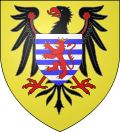 |
House of Wittelsbach (1314–1347)
| Portrait | Name | Election | Coronation | Ceased to be Emperor | Relationship with Predecessor(s) | Coat of arms |
|---|---|---|---|---|---|---|
| Louis IV the Bavarian |
1314 | 17 January 1328 | 11 October 1347 | • 6th generation descendant of Lothair III |
 |
House of Luxembourg (1346–1437)
| Portrait | Name | Election | Coronation | Ceased to be Emperor | Relationship with Predecessor(s) | Coat of arms |
|---|---|---|---|---|---|---|
| Charles IV | 11 July 1346 Re-election 17 June 1349 |
05 April 1355 | 29 November 1378 | • Grandson of Henry VII |
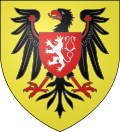 |
| Portrait | Name | Election | Coronation | Ceased to be Emperor | Relationship with Predecessor(s) | Coat of arms |
|---|---|---|---|---|---|---|
| Sigismund | 10 September 1410 Re-election 21 July 1411 |
31 May 1433 | 09 December 1437 | • Son of Charles IV |
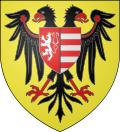 |
House of Habsburg (1440–1740)
| Portrait | Name | Election | Coronation | Ceased to be Emperor | Relationship with Predecessor(s) | Coat of arms |
|---|---|---|---|---|---|---|
| Frederick III | 1440 | 19 March 1452 | 19 August 1493 | • 10th generation descendant of Lothair III |
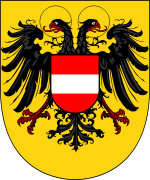 |
| Portrait | Name | Election | Coronation | Ceased to be Emperor | Relationship with Predecessor(s) | Coat of arms |
|---|---|---|---|---|---|---|
| Maximilian I | 19 August 1483 | - [8] |
12 January 1519 | • Son of Frederick III |
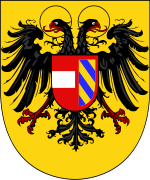 |
| Portrait | Name | Election | Coronation | Ceased to be Emperor | Relationship with Predecessor(s) | Coat of arms |
|---|---|---|---|---|---|---|
| Charles V | 28 June 1519 | 24 Februray 1530 | 27 August 1556 | • Grandson of Maximilian I |
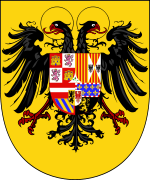 |
| Portrait | Name | Election | Coronation | Ceased to be Emperor | Relationship with Predecessor(s) | Coat of arms |
|---|---|---|---|---|---|---|
| Ferdinand I | 1558 | - [8] |
25 July 1564 | • Grandson of Maximilian I |
 |
| Portrait | Name | Election | Coronation | Ceased to be Emperor | Relationship with Predecessor(s) | Coat of arms |
|---|---|---|---|---|---|---|
| Maximilian II | 25 July 1564 | - [8] |
12 October 1576 | • Son of Ferdinand I |
 |
| Portrait | Name | Election | Coronation | Ceased to be Emperor | Relationship with Predecessor(s) | Coat of arms |
|---|---|---|---|---|---|---|
| Rudolf II [9] |
12 October 1576 | - [8] |
20 January 1612 | • Son of Maximilian II |
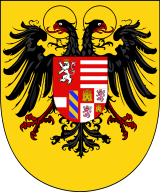 |
| Portrait | Name | Election | Coronation | Ceased to be Emperor | Relationship with Predecessor(s) | Coat of arms |
|---|---|---|---|---|---|---|
| Matthias | 30 June 1612 | - [8] |
20 March 1619 | • Son of Maximilian II |
 |
| Portrait | Name | Election | Coronation | Ceased to be Emperor | Relationship with Predecessor(s) | Coat of arms |
|---|---|---|---|---|---|---|
| Ferdinand II | 26 August 1619 | - [8] |
15 February 1637 | • Grandson of Ferdinand I |
 |
| Portrait | Name | Election | Coronation | Ceased to be Emperor | Relationship with Predecessor(s) | Coat of arms |
|---|---|---|---|---|---|---|
| Ferdinand III | 22 December 1636 | - [8] |
02 April 1657 | • Son of Ferdinand II |
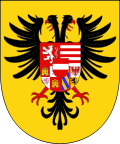 |
| Portrait | Name | Election | Coronation | Ceased to be Emperor | Relationship with Predecessor(s) | Coat of arms |
|---|---|---|---|---|---|---|
| Leopold I | 18 July 1658 | - [8] |
05 May 1705 | • Son of Ferdinand III |
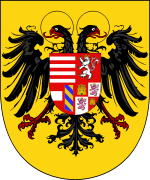 |
| Portrait | Name | Election | Coronation | Ceased to be Emperor | Relationship with Predecessor(s) | Coat of arms |
|---|---|---|---|---|---|---|
| Joseph I | 05 May 1705 | - [8] |
17 April 1711 | • Son of Leopold I |
 |
| Portrait | Name | Election | Coronation | Ceased to be Emperor | Relationship with Predecessor(s) | Coat of arms |
|---|---|---|---|---|---|---|
| Charles VI | 12 October 1711 | - [8] |
20 October 1740 | • Son of Leopold I |
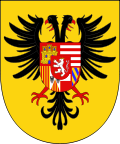 |
House of Wittelsbach (1742–1745)
| Portrait | Name | Election | Coronation | Ceased to be Emperor | Relationship with Predecessor(s) | Coat of arms |
|---|---|---|---|---|---|---|
| Charles VII | 24 January 1742 | - [8] |
20 January 1745 | • Great-great grandson of Ferdinand II |
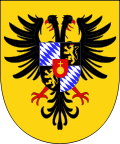 |
House of Habsburg-Lorraine (1745–1806)
| Portrait | Name | Election | Coronation | Ceased to be Emperor | Relationship with Predecessor(s) | Coat of arms |
|---|---|---|---|---|---|---|
| Francis I | 13 September 1745 | - [8] |
18 August 1765 | • Great grandson of Ferdinand III |
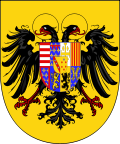 |
| Portrait | Name | Election | Coronation | Ceased to be Emperor | Relationship with Predecessor(s) | Coat of arms |
|---|---|---|---|---|---|---|
| Joseph II | 18 August 1765 | - [8] |
20 February 1790 | • Son of Francis I |
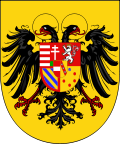 |
| Portrait | Name | Election | Coronation | Ceased to be Emperor | Relationship with Predecessor(s) | Coat of arms |
|---|---|---|---|---|---|---|
| Leopold II | 30 September 1790 | - [8] |
01 March 1792 | • Son of Francis I |
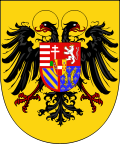 |
| Portrait | Name | Election | Coronation | Ceased to be Emperor | Relationship with Predecessor(s) | Coat of arms |
|---|---|---|---|---|---|---|
| Francis II | 05 July 1792 | - [8] |
06 August 1806 | • Son of Leopold II |
 |
Coronation
The Emperor was crowned in a special ceremony, traditionally performed by the Pope in Rome, using the Imperial Regalia. Without that coronation, no king, despite exercising all powers, could call himself Emperor. In 1508, Pope Julius II allowed Maximilian I to use the title of Emperor without coronation in Rome, though the title was qualified as Electus Imperator Romanorum ("elected Emperor of the Romans"). Maximilian's successors adopted the same titulature, usually when they became the sole ruler of the Holy Roman Empire. Maximilian's first successor Charles V was the last to be crowned Emperor.
| Emperor | Coronation date | Officiant | Location |
|---|---|---|---|
| Charles I | 25 December 800 | Pope Leo III | Rome |
| Louis I | Jul/Aug 816 | Pope Stephen V | Reims |
| Lothair I | 5 April 823 | Pope Paschal I | Rome |
| Louis II | April 850 | Pope Leo IV | Rome |
| Charles II | 29 December 875 | Pope John VIII | Rome |
| Charles III | 12 February 881 | ||
| Guy III of Spoleto | May 891 | Pope Stephen V | |
| Lambert II of Spoleto | 30 April 892 | Pope Formosus | Ravenna |
| Arnulf of Carinthia | 22 February 896 | Rome | |
| Louis III | 15 or 22 Feb 901 | Pope Benedict IV | Rome |
| Berengar | December 915 | Pope John X | Rome |
| Otto I | 2 February, 962 | Pope John XII | |
| Otto II | 25 December, 967 | Pope John XIII | |
| Otto III | 21 May, 996 | Pope Gregory V | |
| Henry II | 14 February 1014 | Pope Benedict VIII | |
| Conrad II | 26 March 1027 | Pope John XIX | |
| Henry III | 25 December 1046 | Pope Clement II | |
| Henry IV | 31 March 1084 | Antipope Clement III | |
| Henry V | 13 April 1111 | Pope Paschal II | |
| Henry V | 23 March 1117 | Antipope Gregory VIII | |
| Lothair III | 4 June 1133 | Pope Innocent II | Basilica of St. John Lateran |
| Frederick I | 18 June 1155 | Pope Adrian IV | |
| Henry VI | 14 April 1191 | Pope Celestine III | |
| Otto IV | 4 October 1209 | Pope Innocent III | |
| Frederick II | 22 November 1220 | Pope Honorius III | |
| Henry VII | 29 June 1312 | Cardinals | |
| Louis IV | 17 January 1328 | Sciarra Colonna | |
| Charles IV | 5 April 1355 | Cardinal | |
| Sigismund | 31 May 1433 | Pope Eugenius IV | |
| Frederick III | 19 March 1452 | Pope Nicholas V | |
| Charles V | February 1530 | Pope Clement VII | Bologna, Italy |
See also
- Concordat of Worms
- Emperor for other uses of the title "Emperor" in western Europe.
- First Council of the Lateran
- Holy Roman Emperors family tree
- Holy Roman Empress
- King of the Romans
- List of German monarchs
References
- ↑ Bryce, James (1968). The Holy Roman Empire. Macmillan. pp. 530.
- ↑ enumerated as successor of Guy II who was Duke of Spoleto 880–883 but not Emperor.
- ↑ enumerated as successor of Lambert I who was Duke of Spoleto 859–880 but not Emperor.
- ↑ enumerated as successor of Henry I who was German King 919–936 but not Emperor.
- ↑ enumerated as successor of Conrad I who was German King 911–918 but not Emperor.
- ↑ Barraclough, Geoffrey (1984). The Origins of Modern Germany. W. W. Norton & Company. ISBN 0393301532. http://books.google.com/books?id=RY6VmGuAaCkC&pg=PA131&lpg=PA131&dq=supplinburg+dynasty&source=web&ots=RsLwH_MnGU&sig=EFPN-WhCOTcfJD4WsWDk39dsGl4.
- ↑ enumerated as successor of Lothair II, who was King of Lotharingia 855–869 but not Emperor.
- ↑ 8.00 8.01 8.02 8.03 8.04 8.05 8.06 8.07 8.08 8.09 8.10 8.11 8.12 8.13 8.14 Emperor-Elect.
- ↑ enumerated as successor of Rudolf I who was German King 1273–1291 but not Emperor.
|
||||||||||||||
|
|||||||||||||||||||
.svg.png)